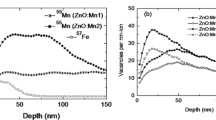Abstract
We have studied the magnetic spinel (Zn)[Fe2]O4 (T_ N\approx10.5\ K) and the non‐magnetic spinels (Zn)[Al2]O4, (Zn)[Ga2]O4, (Zn)[ZnTi]O4 and (Zn)[ZnSn]O4 , both with surface and decay channel muons. In (Zn)[Fe2]O4 the relaxation rate increases monotonically from room temperature down, typical for a paramagnet. Around 30 K, an additional, stronger damped signal appears which is the signature of short‐range ordered (SRO) regions. Their total volume fraction increases drastically towards T_ N (reaching 75%) and astonishingly, continues to be present also below T_ N where the rest of the material has become long‐range ordered. Longitudinal field μSR proves the SRO to be dynamic. In (Zn)[Al2]O4 and (Zn)[Ga2]O4 muon depolarization is caused solely by 27Al or 69,71Ga nuclear dipoles. In the inverse spinel (Zn)[ZnTi]O4, half of the implanted muons depolarize rapidly (\lambda\approx 3μs-1 at room temperature). This, together with repolarization behavior in longitudinal fields indicates that the muon in (Zn)[ZnTi]O4 undergoes a chemical reaction after implantation forming muonium. The fact that no such muonium formation occurred in another inverse spinel ( (Zn)[ZnSn]O4) means that the presence of muonium is not connected to the inverse structure but rather due to the presence of Ti which offers two d‐electrons to participate in the chemical bonding. Additional evidence for d‐electron participation is provided by 67Zn‐Mössbauer data which indicate unusual electron densities at the 67Zn nuclei only in (Zn)[ZnTi]O4.
Similar content being viewed by others
References
D.C. Johnston, J. Low Temp. Phys. 25 (1976) 145.
R.W. McCallum, D.C. Johnston, C.A. Luengo and M.B. Maples, J. Low Temp. Phys. 25 (1976) 177.
R.E. Vandenberghe and E. De Grave, in: Mössbauer Spectroscopy Applied to Inorganic Chemistry, Vol. 3, eds. G.J. Long and F. Grandjean (Plenum Press, New York, 1989).
W. Potzel, G.M. Kalvius, W. Schiessl, H. Karzel, A. Kratzer, M.K. Krause, A. Schneider, I. Halevy, J. Gal, G. Will, M. Hillberg, R. Wäppling, D.W. Mitchell and T.P. Das, Hyp. Int. 97/98 (1996) 373.
W. Schiessl, W. Potzel, H. Karzel, M. Steiner, G.M. Kalvius, A. Martin, M.K. Krause, I. Halevy, J. Gal, W. Schäfer, G. Will, M. Hillberg and R. Wäppling, Phys. Rev. B 53 (1996) 9143.
C. Hohenemser, N. Rosov and A. Kleinhammes, Hyp. Int. 49 (1989) 267.
Author information
Authors and Affiliations
Rights and permissions
About this article
Cite this article
Burghart, F., Potzel, W., Kalvius, G. et al. Muons and muonium in Zn‐spinels. Hyperfine Interactions 106, 187–192 (1997). https://doi.org/10.1023/A:1012650110142
Issue Date:
DOI: https://doi.org/10.1023/A:1012650110142




